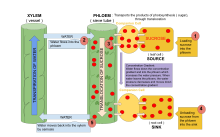
Back Stingel Afrikaans Tallo (botanica) AN ساق نبات Arabic Tarmu AST Ali lawa Aymara گؤوده (ساقه) AZB Schtengl BAR Stombris BAT-SMG Сцябло Byelorussian Сьцябло BE-X-OLD
This article needs additional citations for verification. (March 2022) |



A stem is one of two main structural axes of a vascular plant, the other being the root. It supports leaves, flowers and fruits, transports water and dissolved substances between the roots and the shoots in the xylem and phloem, engages in photosynthesis, stores nutrients, and produces new living tissue.[1] The stem can also be called the culm, halm, haulm, stalk, or thyrsus.
The stem is normally divided into nodes and internodes:[2]
- The nodes are the points of attachment for leaves and can hold one or more leaves. There are sometimes axillary buds between the stem and leaf which can grow into branches (with leaves, conifer cones, or flowers).[2] Adventitious roots (e.g. brace roots) may also be produced from the nodes. Vines may produce tendrils from nodes.
- The internodes distance one node from another.[2]
The term "shoots" is often confused with "stems"; "shoots" generally refers to new fresh plant growth, including both stems and other structures like leaves or flowers.[2]
In most plants, stems are located above the soil surface, but some plants have underground stems.
Stems have several main functions:[3]
- Support for and the elevation of leaves, flowers, and fruits. The stems keep the leaves in the light and provide a place for the plant to keep its flowers and fruits.
- Transport of fluids between the roots and the shoots in the xylem and phloem.
- Storage of nutrients.
- Production of new living tissue. The normal lifespan of plant cells is one to three years. Stems have cells called meristems that annually generate new living tissue.
- Photosynthesis.
Stems have two pipe-like tissues called xylem and phloem. The xylem tissue arises from the cell facing inside and transports water by the action of transpiration pull, capillary action, and root pressure. The phloem tissue arises from the cell facing outside and consists of sieve tubes and their companion cells. The function of phloem tissue is to distribute food from photosynthetic tissue to other tissues. The two tissues are separated by cambium, a tissue that divides to form xylem or phloem cells.
- ^ Plant Stems: Physiology and Functional Morphology. Elsevier. 1995-07-19. ISBN 978-0-08-053908-9.
- ^ a b c d Britannica Lessons Class VI Science The Living World. Popular Prakashan. 2002. ISBN 9788171549719.
- ^ Raven, Peter H., Ray Franklin Evert, and Helena Curtis (1981). Biology of Plants. New York: Worth Publishers. ISBN 0-87901-132-7.